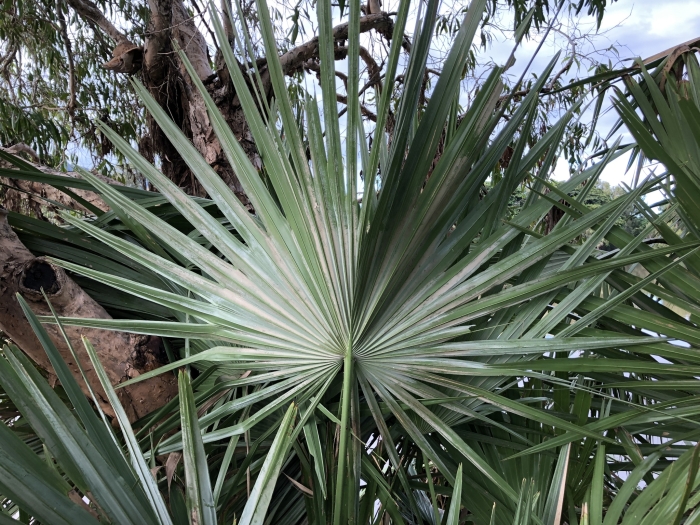Cabbage-Tree Palm
(Livistona australis)
Cabbage-Tree Palm (Livistona australis)
/
/

elawrey
CC BY 4.0
Image By:
elawrey
Recorded By:
Copyright:
CC BY 4.0
Copyright Notice:
Photo by: elawrey | License Type: CC BY 4.0 | License URL: http://creativecommons.org/licenses/by/4.0/ | Rights Holder: elawrey | Publisher: iNaturalist | Date Created: 2019-03-30T21:25:48Z |



















































Estimated Native Range
Summary
Livistona australis, commonly known as Cabbage-Tree Palm, is an evergreen palm tree native to the moist open forests, swamps, and riverbanks of Eastern Australia. It can grow up to about 25 meters in height and has a trunk diameter of around 0.35 meters. The Cabbage-Tree Palm is characterized by its tall, slender trunk and a crown of dark, glossy green leaves that are plaited like a fan and can extend on petioles up to 2 meters long. During the summer months, it produces flower spikes with sprigs of cream-white flowers, which are followed by small, round, black fruits that are attractive to wildlife.
This palm is valued for its elegant form and the tropical aesthetic it brings to landscapes. It is adaptable to a range of conditions, being salt, frost, and wind tolerant, making it suitable for coastal plantings and urban environments where such tolerances are beneficial. The Cabbage-Tree Palm is often used as a focal point in gardens and public spaces. It requires moist, organically-rich soils and can thrive in both sheltered and well-lit situations. While it prefers full sun, it can also tolerate some shade. It has low to medium water requirements and can adapt to soils with varying drainage speeds. Despite its adaptability, it is important to avoid waterlogged conditions to prevent root rot.CC BY-SA 4.0
This palm is valued for its elegant form and the tropical aesthetic it brings to landscapes. It is adaptable to a range of conditions, being salt, frost, and wind tolerant, making it suitable for coastal plantings and urban environments where such tolerances are beneficial. The Cabbage-Tree Palm is often used as a focal point in gardens and public spaces. It requires moist, organically-rich soils and can thrive in both sheltered and well-lit situations. While it prefers full sun, it can also tolerate some shade. It has low to medium water requirements and can adapt to soils with varying drainage speeds. Despite its adaptability, it is important to avoid waterlogged conditions to prevent root rot.CC BY-SA 4.0
Plant Description
- Plant Type: Tree
- Height: 50-75 feet
- Width: 15-20 feet
- Growth Rate: Slow
- Flower Color: N/A
- Flowering Season: Spring, Summer
- Leaf Retention: Evergreen
Growth Requirements
- Sun: Full Sun
- Water: Medium
- Drainage: Slow, Medium, Fast
Common Uses
Bird Garden, Edible*Disclaimer: Easyscape's listed plant edibility is for informational use. Always verify the safety and proper identification of any plant before consumption., Low Maintenance, Street Planting
Natural Habitat
Moist open forests, swamps, and riverbanks of Eastern Australia
Other Names
Common Names: Australian Palm, Cabbage Palm, Gippsland Palm
Scientific Names: , Livistona australis, Corypha australis,
GBIF Accepted Name: Livistona australis (R.Br.) Mart.